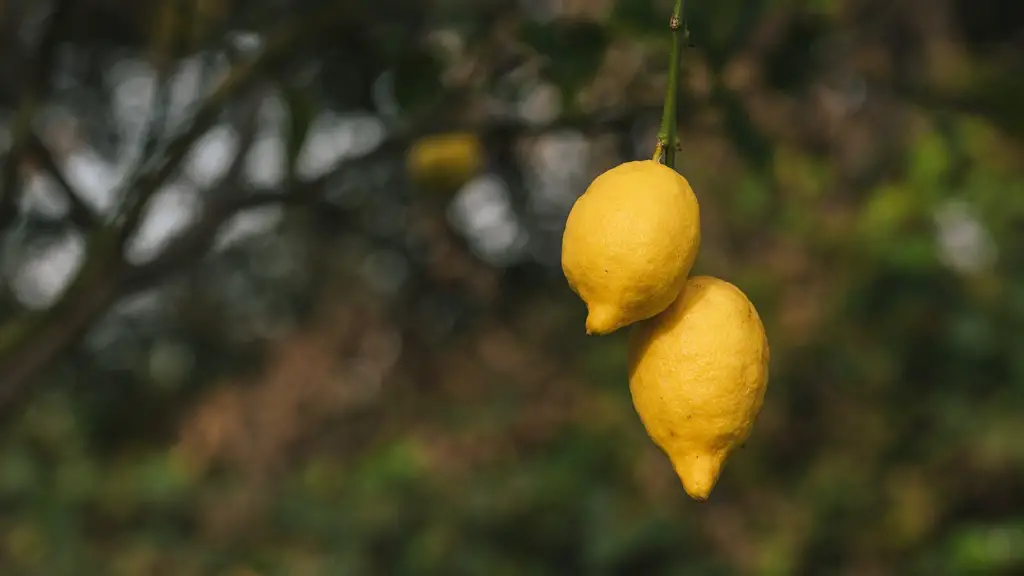Avocado trees come in several varieties and require specific soil, temperature and sun exposure in order to produce fruit. For anyone looking to grow their own avocado tree, it’s important to select the best possible location for planting and care. First and foremost, the location should be in an area where the soil is deep and well-draining. Avocados thrive in nutrient-rich soil, so incorporating organic matter into the soil before planting is beneficial. It’s also important to select a spot that receives full sun and has some sort of natural wind break, like a fence.
With regard to the amount of space an avocado tree requires, the general consensus among experts is to plant your tree at least 8 to 10 feet away from other trees and structures. In some cases, it might even be necessary to plant a tree up to 15 feet away from other trees to ensure that it will thrive. The further the tree is planted from other trees, the more room it has to develop a healthy, strong root system as well as efficient uptake of essential nutrients, including water.
It’s common practice to plant avocado trees in the spring or fall when the weather isn’t too hot. So if you plan to plant an avocado tree in the spring, make sure to select a spot that is easily accessible and receives plenty of direct sunlight throughout the day. On the other hand, if you are planting in the fall, choose a spot that will be protected from cold winter winds.
When it comes to selecting the right variety of avocado tree that is best suited for your climate, it is important to do your research. Choose a cultivar that is known for growing in your area and check the tags of the trees before purchasing. It’s best to opt for a variety that has the same pollination type as any neighbouring trees in order to maximise the chances of successful pollination and overall fruit production.
Finally, don’t forget to water your avocado tree correctly. Established trees should be watered every two to three weeks, while young trees need more frequent watering—about one inch of water every seven to ten days. In warmer climates, you may need to water more frequently, while in cooler areas water may be needed only every two or three weeks.
Soil Preparation For Best Results
When it comes to growing an avocado tree, the quality of the soil is just as important as the location. The soil should be well-draining and nutrient-rich. Fertiliser and soil amendments should be added to the planting site before the tree is planted in order to improve the soil’s ability to hold moisture and nutrients. This aids the tree’s overall health and helps to ensure it will thrive.
Organic matter such as compost can also be mixed into the soil before planting. compost helps to improve the soil’s ability to retain moisture and also provides beneficial microorganisms, which can help the tree to take up the soil’s nutrients more effectively. Compost also promotes drainage, which is important for avocado trees as they are susceptible to root rot.
In addition, the soil’s pH level should be tested before planting. Ideally, the pH should be between 6 and 7 in order for the tree to absorb essential nutrients. If the pH is too high or low, soil amendments can be used to adjust the pH levels.
For best results, it is also important to make sure the planting site is free of any weeds or grass. Any weed or grass competition will interfere with the tree’s ability to absorb essential nutrients and water, so it is important to make sure the planting site is free of any potential competitors.
Sun Exposure Makes a Difference
The amount of sunlight an avocado tree receives is also an important factor for successful growth. Avocado trees prefer full sun, so make sure to choose a location that receives at least eight hours of direct sunlight per day for optimal results. If the tree does not receive enough sun, the leaves may become pale and the tree’s growth may become stunted.
In addition, it is important to make sure the tree is not exposed to strong winds, as this can cause the leaves to dry out and cause damage to the tree. If the tree is located in an area that is exposed to strong winds, it is important to provide some sort of wind break, such as a fence or thick shrubs.
Pruning an Avocado Tree
Pruning is also an important aspect of caring for an avocado tree. It is important to prune the tree regularly in order to maintain a healthy and productive tree. Pruning helps to promote new growth and also helps to control the size of the tree. The best time to prune an avocado tree is in the spring or early summer, but it is important to make sure the tree is not pruned too severely as this can cause injury or damage to the tree.
When pruning an avocado tree, it is important to only remove dead or damaged branches. Additionally, it is beneficial to thin out the canopy in order to improve air circulation and to ensure that all parts of the tree are getting the right amount of sunlight. Pruning an avocado tree is an essential part of caring for the tree and should be done on a regular basis in order to promote healthy growth.
Choosing the Right Variety of Avocado Tree
When deciding which variety to plant, it is important to research the different types of avocado trees that are available. The best avocado trees for your region will depend on the climate and soil conditions. Some varieties may be better suited for hotter climates, while others may be ideal for cooler climates. Additionally, some varieties may produce better fruit than others in certain regions.
When selecting the right variety for your area, it is also important to consider the tree’s pollination requirements. Depending on the type of avocado tree you want to plant, self-pollinating and cross-pollinating varieties may be available. Self-pollinating varieties are ideal if there are no other avocado trees in the area, while cross-pollinating varieties are best if there are other avocado trees nearby.
Watering Requirements For Best Results
In order to promote healthy, vigorous growth, it is important to water avocado trees correctly. Established trees should be watered deeply every two to three weeks, while young trees need to be watered every 7 to 10 days. In warmer climates, more frequent watering may be necessary, while in cooler climates, watering may be needed only every two to three weeks.
In addition, it is important to make sure the roots of the tree are kept moist. To test the soil’s moisture level, insert your finger into the soil. If it is dry, then it is time to water the tree. Additionally, mulching the soil around the tree can also help to retain moisture and regulate the soil temperature.
Fertilizing Avocado Trees
Fertilising an avocado tree is also important if you want to get the best possible results. Fertilising helps to provide the tree with essential nutrients that are not present in the soil. When fertilising, look for a fertiliser that is specifically formulated for avocado trees. Fertilisers that contain a balanced combination of nitrogen, phosphorus, and potassium are ideal, as they help to promote healthy, vigorous tree growth.
It is also important to keep in mind that fertilising too often can be detrimental to the health of the tree, so it is best to follow the directions on the fertiliser package and apply the fertiliser at the correct intervals. Too much fertiliser can lead to a build up of salts in the soil, which can then be absorbed by the tree, causing root burn and other problems.
Caring For the Health and Productivity of Your Avocado Tree
Caring for an avocado tree is an important part of ensuring it produces a healthy crop of fruit each year. When planting an avocado tree, it is important to select the best possible location and use soil amendments to improve the soil’s ability to hold moisture and nutrients. The tree should also be exposed to the right amount of sunlight and protected from strong winds. It is also essential to prune the tree regularly, water it correctly and fertilise it at the appropriate intervals if you want the tree to thrive.
By following these tips, you can ensure your avocado tree is healthy and productive for many years to come. With proper planting, soil preparation, sun exposure, pruning, watering, and fertilising, you can reap a bountiful harvest of delicious avocados.




